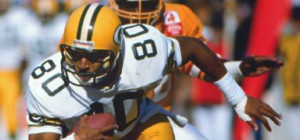by Chase Stuart
on July 31, 2018
Yesterday, I wrote about how Michael Irvin was dominant in Receiving Yards per adjusted Team Pass Attempts. From 1991 to 1996, he ranked 1st in that category three times, and 2nd in the other three seasons. From a Gray Ink perspective, that would mean he would get 10 points each for his three first place finishes and 9 points each for his three second place finishes, for a total of 57 points. He also ranked 10th in 1998, which would give him one more point.
The fact that I wrote about Irvin yesterday wasn’t a coincidence. I calculated the Gray Ink for each receiver in NFL history in RY/aTPA, and Irvin’s 58 points (which turns out to be 55 points after you adjust for the number of teams in the league) was the third best in NFL history. Here are the top 75 receivers by this metric. You can read the table below as follows. Jerry Rice played from 1985 to 2004, and accumulated 92 points of Gray Ink, where a 1st-place finish in Receiving Yards/adjusted Team Pass Attempt is worth 10 points, a 2nd-place finish 9 points, a 3rd-place finish 8 points, and so on. The final column is a pro-rated value number, which lowers the value gives in seasons where there were fewer than 32 teams. This most clearly impacts older players like Don Hutson, who drops from 102 points to 66.9 points. [continue reading…]
Tagged as:
James Lofton,
Paul Warfield
{ }
by Chase Stuart
on July 27, 2014
Yesterday, we looked at which quarterbacks were the best at yards per completion after adjusting for league average. Today, we’ll do the same thing for wide receivers and yards per completion.

Lofton tries to hide from the creamsicle uniforms.
A small tweak is necessary to the formula. You can skip down to the results section if you don’t care about the math, but I suppose most of my readers want to know what goes in the sausage. We can’t just use league-wide yards per completion rates, since that average includes receptions by non-wide receivers. One way around this is to calculate the league average YPC for wide receivers only; that’s easy to do for 2013, but less easy to do for the earlier years of NFL history when the distinction among the positions was not so clear. So, after playing around with a few different methods, I’ve decided to instead use 120% of the league average YPC rate, and give wide receivers credit for their yards over expectation using that inflated number.
For example, in 1983, James Lofton caught 58 passes for 1,300 yards for the Packers, a 22.4 YPC average. That year, the average reception went for 12.63 yards; 120% of that average is 15.2, which means we would give Lofton credit only for his yards over the product of 15.2 and 58, or 879. Since Lofton actually had 1,300 yards, he gets credit for 421 yards over expectation.
The next year, Lofton caught 62 passes for 1,361 yards (22.0). Since the average reception went for 12.66 yards, Lofton gets credit for his yards over (120% * 12.66 * 62), or 942. Lofton therefore is credited with 419 yards over expectation, nearly identical to his performance in the prior year. In fact, those were the 10th and 11th best season in NFL history by this method. [continue reading…]
Tagged as:
Henry Ellard,
James Lofton,
Paul Warfield,
Randy Moss,
Stanley Morgan
{ }

